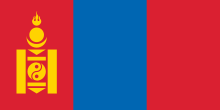Mongolia coat of arms
The coat of arms of Mongolia ( Mongolian Монгол улсын төрийн сүлд / Mongol ulsyn töriin süld ) was enshrined in the 1992 constitution. It replaced the coat of arms previously used by the Mongolian People's Republic .
description
The coat of arms has a circular shape, with a foot in the shape of a white lotus . An "infinite Tumen Nasan" runs along the circumference, a continuous ornament of regularly crossing lines similar to the running dog of European antiquity.
The base is blue and symbolizes the eternal blue sky, which the Mongols traditionally consider sacred. In the middle is a wind horse in combination with the Soyombo symbol as an expression of independence, sovereignty and spirit of Mongolia.
At the top, the three jewels interrupt the border ornament. The jewels symbolize the past, present and future. In the lower area of the circle there is a Dharma wheel, which is braided with a chatag (prayer sash). The two elements are an expression of awe and respect and symbolize continued prosperity. Behind it is a pattern of green hills, which symbolizes mother earth.
Origin of symbols
The worship of Father Sky ( Old Turkish Tengri , Mongolian Tenger ) and Mother Earth originated from the shamanistic beliefs of Tengriasm which was widespread among the nomadic peoples of Central Asia. Shamanism and its symbols live on in Mongolia alongside Buddhism to this day. The color blue can be found in the same tradition in the national symbols of other peoples in the region.
The Sojombo symbol , which is also shown on the Mongolian flag , is a special character to mark the beginning of the text from the old Mongolian Sojombo script .
The other symbols come from the Tibetan Buddhism (Lamaism) practiced in Mongolia .
use
Images of the national coat of arms can be found on official documents, in the premises of the state organs and on the outside of their buildings.
State seal
The state seal also depicts the coat of arms within a square outline. The word "Mongolia" in Mongolian is written in different scripts along the edges of the square. The seal itself has a handle in the shape of a lion and is in the care of the President.
Historical coat of arms
From 1960 to 1991 the Mongolian People's Republic used a coat of arms with a similar basic shape, but with a few different elements.
Instead of the wind horse with soyombo, a normal horse with a rider is shown. In the background a sun rises over mountains. Instead of Buddhist symbols, symbols of socialism are used. A cog wheel at the base symbolizes industrialization, sheaves of wheat as a border symbolize the peasant class, and at the top there is a red star with the socialist version of Soyombo. At the bottom there is a red-blue-red band in front of the gear with the words "БНМАУ", the abbreviation for Бүгд Найрамдах Монгол Ард Улс (Mongolian People's Republic).
The versions of the coat of arms used between 1940 and 1960 had a similar structure, but the rider carried a traditional lasso rod (Urga) in his hand. In addition, the sheaves of wheat, the cogwheel and the Soyombo symbol were missing.





